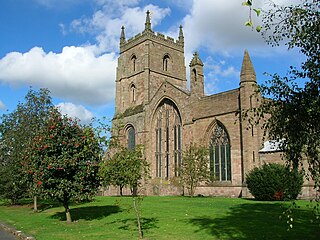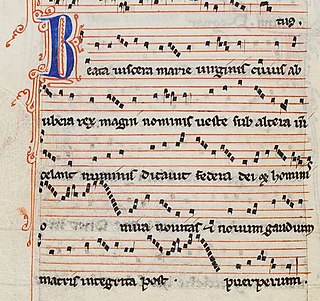Related Research Articles

In Western classical music, a motet is mainly a vocal musical composition, of highly diverse form and style, from high medieval music to the present. The motet was one of the pre-eminent polyphonic forms of Renaissance music. According to Margaret Bent, "a piece of music in several parts with words" is as precise a definition of the motet as will serve from the 13th to the late 16th century and beyond. The late 13th-century theorist Johannes de Grocheo believed that the motet was "not to be celebrated in the presence of common people, because they do not notice its subtlety, nor are they delighted in hearing it, but in the presence of the educated and of those who are seeking out subtleties in the arts".

Worcester Cathedral, formally the Cathedral Church of Christ and Blessed Mary the Virgin, is a Church of England cathedral in Worcester, England. The cathedral is the seat of the bishop of Worcester and is the mother church of the diocese of Worcester; it is administered by its dean and chapter. The cathedral is a grade I listed building and part of a scheduled monument.

Leominster is a market town in Herefordshire, England; it is located at the confluence of the River Lugg and its tributary the River Kenwater. The town is 12 miles north of Hereford and 7 miles south of Ludlow in Shropshire. With a population of 11,700, Leominster is the largest of the five towns in the county; the others being Ross-on-Wye, Ledbury, Bromyard and Kington.
Pérotin was a composer associated with the Notre Dame school of polyphony in Paris and the broader ars antiqua musical style of high medieval music. He is credited with developing the polyphonic practices of his predecessor Léonin, with the introduction of three and four-part harmonies.
Organum is, in general, a plainchant melody with at least one added voice to enhance the harmony, developed in the Middle Ages. Depending on the mode and form of the chant, a supporting bass line may be sung on the same text, the melody may be followed in parallel motion, or a combination of both of these techniques may be employed. As no real independent second voice exists, this is a form of heterophony. In its earliest stages, organum involved two musical voices: a Gregorian chant melody, and the same melody transposed by a consonant interval, usually a perfect fifth or fourth. In these cases the composition often began and ended on a unison, the added voice keeping to the initial tone until the first part has reached a fifth or fourth, from where both voices proceeded in parallel harmony, with the reverse process at the end. Organum was originally improvised; while one singer performed a notated melody, another singer—singing "by ear"—provided the unnotated second melody. Over time, composers began to write added parts that were not just simple transpositions, thus creating true polyphony.
Antoine Brumel was a French composer. He was one of the first renowned French members of the Franco-Flemish school of the Renaissance, and, after Josquin des Prez, was one of the most influential composers of his generation.

"Sumer is icumen in" is the incipit of a medieval English round or rota of the mid-13th century; it is also known variously as the Summer Canon and the Cuckoo Song.
Anonymous IV is the designation given to the writer of an important treatise of medieval music theory. He was probably an English student working at Notre Dame de Paris, most likely in the 1270s or 1280s. Nothing is known about his life. His writings survive in two partial copies from Bury St Edmunds; one from the 13th century, and one from the 14th.

The conductus was a sacred Latin song in the Middle Ages, one whose poetry and music were newly composed. It is non-liturgical since its Latin lyric borrows little from previous chants. The conductus was northern French equivalent of the versus, which flourished in Aquitaine. It was originally found in the twelfth-century Aquitanian repertories. But major collections of conducti were preserved in Paris. The conductus typically includes one, two, or three voices. A small number of the conducti are for four voices. Stylistically, the conductus is a type of discant. Its form can be strophic or through-composed form. The genre flourished from the early twelfth century to the middle of thirteenth century. It was one of the principal types of vocal composition of the ars antiqua period of medieval music history.

The Winchester Troper refers to two eleventh-century manuscripts of liturgical plainchant and two-voice polyphony copied and used in the Old Minster at Winchester Cathedral in Hampshire, England. The manuscripts are now held at Cambridge, Corpus Christi College 473 and Oxford, Bodleian Library Bodley 775 . The term "Winchester Troper" is best understood as the repertory of music contained in the two manuscripts. Both manuscripts contain a variety of liturgical genres, including Proper and Ordinary chants for both the Mass and the Divine Office. Many of the chants can also be found in other English and Northern French tropers, graduals, and antiphoners. However, some chants are unique to Winchester, including those for local saints such as St. Æthelwold and St. Swithun, who were influential Bishops of Winchester in the previous centuries. Corpus 473 contains the most significant and largest surviving collection of eleventh-century organum. This polyphonic repertoire is unique to that manuscript.

The Trecento was a period of vigorous activity in Italy in the arts, including painting, architecture, literature, and music. The music of the Trecento paralleled the achievements in the other arts in many ways, for example, in pioneering new forms of expression, especially in secular song in the vernacular language, Italian. In these regards, the music of the Trecento may seem more to be a Renaissance phenomenon; however, the predominant musical language was more closely related to that of the late Middle Ages, and musicologists generally classify the Trecento as the end of the medieval era. Trecento means "three hundred" in Italian but is usually used to refer to the 1300s. However, the greatest flowering of music in the Trecento happened late in the century, and the period is usually extended to include music up to around 1420.

Music manuscripts are handwritten sources of music. Generally speaking, they can be written on paper or parchment. If the manuscript contains the composer's handwriting it is called an autograph. Music manuscripts can contain musical notation as well as texts and images. There exists a wide variety of types from sketches and fragments, to compositional scores and presentation copies of musical works.
The Worcester Fragments are a collection of medieval music associated with Worcester, England.
The Saint Martial School was a medieval school of music composition centered in the Abbey of Saint Martial, Limoges, France. Most active from the 9th to 12th centuries, some scholars describe its practices, music, and manuscripts as 'Aquitanian'. It is known for the composition of tropes, sequences, and early organum. In this respect, it was an important precursor to the Notre Dame School. Adémar de Chabannes and his nephew Roger de Chabannes were important proponents of this school whose hands had only be recently discovered by studies of James Grier between 1995 and 2005. They invented a local variant of a vertically precise organisation of notation and a new form of local tonary, they reorganised existing chant manuscripts, and they developed the libellum structure of a new type of sequentiary troper whose organisation was new at their time, but played a key role for the Saint Martial school.

The Montpellier Codex is an important source of 13th-century French polyphony. The Codex contains 336 polyphonic works probably composed c. 1250–1300, and was likely compiled c. 1300. It is believed to originate from Paris. It was discovered by musicologist Edmond de Coussemaker in c. 1852.
In music, especially Schenkerian analysis, a voice exchange is the repetition of a contrapuntal passage with the voices' parts exchanged; for instance, the melody of one part appears in a second part and vice versa. It differs from invertible counterpoint in that there is no octave displacement; therefore it always involves some voice crossing. If scored for equal instruments or voices, it may be indistinguishable from a repeat, although because a repeat does not appear in any of the parts, it may make the music more interesting for the musicians. It is a characteristic feature of rounds, although not usually called such.
The Trent Codices are a collection of seven large music manuscripts compiled around the middle of the 15th century, currently kept in the northern Italian city of Trent. They contain mostly sacred vocal music composed between 1400 and 1475. Containing more than 1,500 separate musical compositions by 88 different named composers, as well as a huge amount of anonymous music, they are the largest and most significant single manuscript source from the entire century from anywhere in Europe.

Early music of Britain and Ireland, from the earliest recorded times until the beginnings of the Baroque in the 17th century, was a diverse and rich culture, including sacred and secular music and ranging from the popular to the elite. Each of the major nations of England, Ireland, Scotland, and Wales retained unique forms of music and of instrumentation, but British music was highly influenced by continental developments, while British composers made an important contribution to many of the major movements in early music in Europe, including the polyphony of the Ars Nova and laid some of the foundations of later national and international classical music. Musicians from the British Isles also developed some distinctive forms of music, including Celtic chant, the Contenance Angloise, the rota, polyphonic votive antiphons, and the carol in the medieval era and English madrigals, lute ayres, and masques in the Renaissance era, which would lead to the development of English language opera at the height of the Baroque in the 18th century.

Music in Medieval England, from the end of Roman rule in the fifth century until the Reformation in the sixteenth century, was a diverse and rich culture, including sacred and secular music and ranging from the popular to the elite.

The Selden Carol Book is a medieval carol manuscript held by the Bodleian Library in Oxford. Along with the Trinity Carol Roll, with which it shares five contemporaneous carols and texts, it is one of the main sources for 15th century English carols, and like the Trinity Roll contains the music as the well as the texts. The inclusion of Deo Gracias Anglia referencing Henry V's victory at Agincourt in 1415 gives an indication of the date of composition of the carols.
References
- 1 2 "Wycombe [Wicumbe, ?Whichbury, Winchecumbe], W. de" . Retrieved 29 February 2012.
- ↑ Sanders (in Grove) considers the identification of the composer with Willelmus de Winchecumbe improbable.